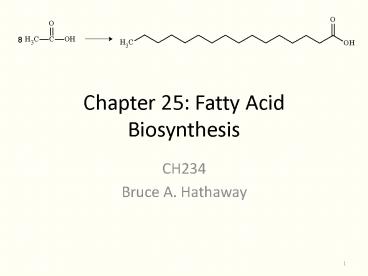Chapter 25: Fatty Acid Biosynthesis PowerPoint PPT Presentation
1 / 16
Title: Chapter 25: Fatty Acid Biosynthesis
1
Chapter 25 Fatty Acid Biosynthesis
- CH234
- Bruce A. Hathaway
2
Acetyl Coenzyme A
- Acetyl Coenzyme A is the starting material for
fatty acid biosynthesis. - It is derived from metabolism of carbohydrates,
fats and some amino acids. - The two-carbon piece provides the carbons for the
new fatty acid.
Acetyl Coenzyme A
3
Acetyl Coenzyme A (AcCoA)
4
Overview of Metabolism And Energy Production
5
Step 1 Preparation of Malonyl CoA
- Acetyl CoA reacts with bicarbonate to form
Malonyl CoA. - This is energy-requiring, so hydrolysis of an ATP
is used to drive the reaction. - Malonyl CoA is more reactive than Acetyl CoA.
6
Step 2 Transthioesterifaction
- Both Acetyl CoA and Malonyl CoA are connected to
Acetyl Carrier Protein (ACP), which is another
thiol. - One thiol replaces another to make a different
thioester. - ACP shuttles the molecules to the different
enzymes needed to do the following reactions.
7
Step 3 C-C Bond Formation
- Malonyl ACP loses CO2 to make a carbon anion.
- An acetyl ACP reacts with the carbon anion to
give a four-carbon ß-ketoester.
8
Step 4 Reduction of the Ketone
- The ketone is reduced to an alcohol.
- Only one stereoisomer is produced why?
- NADPH functions similar to NaBH4 in this reaction.
9
NADPH
- NADPH is similar to NADH.
- It has an extra phosphate, while NADH has an H.
- Metabolism uses NADH.
- Biosynthesis uses NADPH.
10
Reduction of the Ketone with NADPH
- NADPH donates a hydride H- to reduce the ketone
the H comes from water, ultimately. - Only one enantiomer is formed.
11
Step 5 Dehydration of the Alcohol
- The alcohol is specifically dehydrated to the
trans alkene. - Again, only one isomer is formed.
12
Step 6 Reduction of the Alkene
- NADPH H reduces the CC to an alkane.
- We have now made a four-carbon fatty acid.
13
Elongation of Fatty Acids
- The Butyroyl-ACP replaces the Acetyl-ACP in Step
3, to make a 6-carbon ketoacid.
14
Elongation of Fatty Acids
- The 6-carbon keto-acid is reduced, dehydrated,
and reduced again (steps 4-6), to make the
six-carbon fatty acid. - This can react with more malonyl-ACP
15
Elongation of Fatty Acids
- The cycle of steps 3-6 is repeated five more
times until the 16-carbon fatty acid is made. - For some reason, this enzyme complex only makes
palmitic acid. - Longer fatty acids and unsaturated fatty acids
are synthesized in other locations.
16
Energy Requirements
- To add two carbons to Acetyl CoA, it requires 1
ATP (to make a malonyl CoA) and 2 NADPHs. - Each NADPH is the equivalent to 2.5 ATPs.
- Therefore, it takes the equivalent of 6 ATPs to
add two carbons to Acetyl CoA. - To make a 12-carbon fatty acid, lauric acid,
requires five cycles, or 30 ATPs. - This compares to the 20 ATPs we get from
metabolizing lauric acid to Acetyl CoA.

